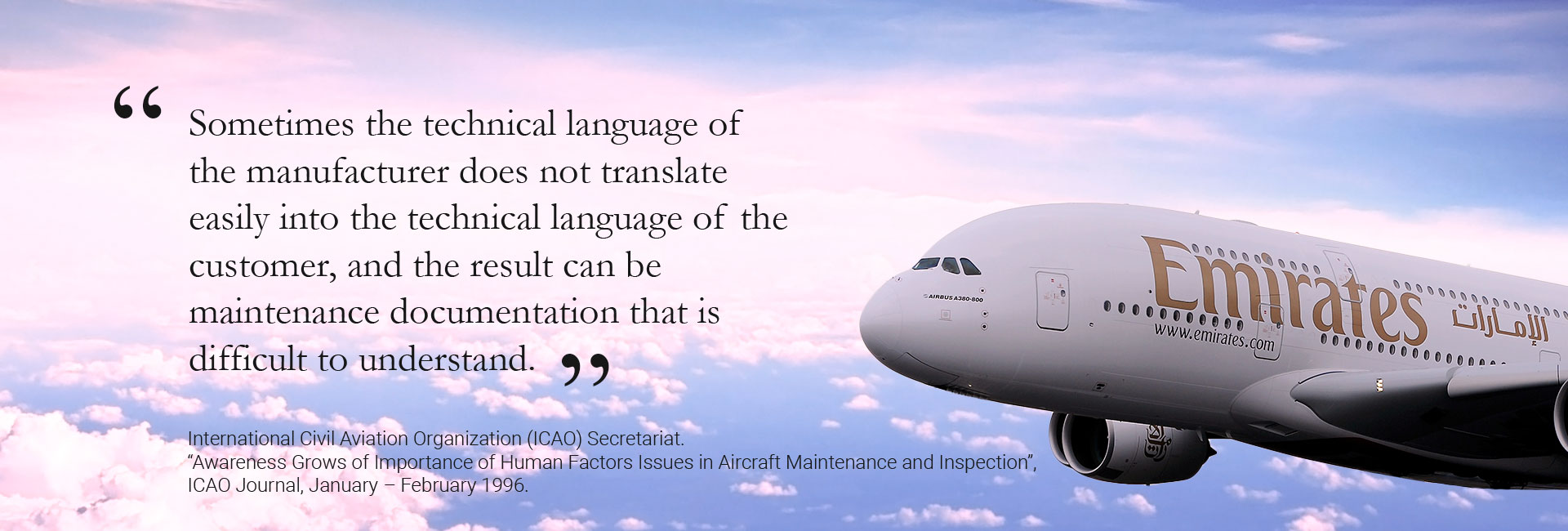Why Simplified Technical English (STE)?
Whether you are looking to implement working standards such as DITA, S1000D, ATA iSpec 2200, RailDex, or ShipDex to standardise your information structure and facilitate content re-use, it is important to give due consideration to the quality of your source text when creating your technical content. Ambiguous or inconsistently worded documentation can result in non-compliant data deliveries, poor customer support, potential legal liabilities, equipment damage, as well as safety risks.
A well-written source text ensures the ease of downstream content management processes such as translations

Improved readability for your technical content
STE prescribes the use of grammar rules that are relatively more restrictive than the standard rules of the English language.
The general vocabulary has only 900 approved words while explicitly listing 1500 other non-approved words with alternative suggestions.
By introducing these grammar and vocabulary restrictions, technical authors can avoid writing overly long sentences and leave out unnecessary technical details where applicable, all of which are obstacles to the ease of readability and sound understanding.
Recommended by global documentation standards
Military defence standards (MIL-SPEC / MIL-STD) such as MIL-STD-3048, as well as technical documentation standards like S1000D and ATA iSpec 2200 recommend the use of ASD-STE100.
Although the S1000D standard was originally intended for the aerospace and defence industry, this widely successful specification has been customised for the shipping and train manufacturing and operations communities giving rise to both ShipDex and RailDex. Likewise, sound and consistent STE writing rules are highly applicable and practical for use across industries.
Simplifying or eliminating the need for translations?
STE is an international aerospace standard that helps to make technical documentation easy to understand. However, the benefits of STE have proven very highly applicable to all industries. That is why 60% of STE users today come from industries outside of aerospace & defence.
Understandably, STE was designed with non-native speakers of the English language in mind. By providing technical writers with a common set of standardised writing rules and general vocabulary, STE enables teams of writers to write technical manuals that are consistently accurate and require less proofreading and editing effort. Consequently, this does away with the need for translations altogether.
Besides the aerospace maintenance industry however, product exports are still subjected to much scrutiny in terms of their paperwork, documentation and associated product translations. Therefore, the use of STE to create technical content can support downstream translation processes in several ways:
- A 900-word general vocabulary dictionary eliminates the need for other non-approved, and possibly uncommon synonyms. This reduces the likelihood of term-related clarifications and queries from translators, resulting in faster translation processes.
- Enforcing STE rules strictly guarantees a high level of consistency at word-, phrase-, and sentence-levels. This allows project managers to leverage on existing translation memories to substantially reduce translation costs.
- With fewer technical terms to translate and a more uniform translation memory, translators can provide cheaper, faster and better translations thanks to STE.
- Having STE content in place will result in exceptional translation quality with machine translations as well.
In a nutshell
For many years now, the use of STE as a controlled language authoring strategy has successfully taken off not just at large organisations, but also in small and medium enterprises.
With professional Simplified Technical English training that costs only a fraction of supposed “full implementation”, and yet achieves 75% – 85% of the benefits and results of an approach that includes checker software, getting started with STE is no longer the major and expensive investment it used to be.
Training technical writers and engineers to write in STE within two to three days may sound like a simple and straightforward undertaking. However, to change the way your technical authoring team works does require some managerial direction while the team transits to STE. Trained technical writers will experience on a more regular basis, the many benefits that STE as a controlled language writing strategy offers.
About the author
Since 2006, Ms Shumin Chen has been working as a consultant with customers in various industries worldwide: aerospace and defence, banking, consumer products, healthcare, IT, medical and fitness equipment. She has helped many companies with their documentation needs, based on standards where possible, and is widely regarded as a leading expert in ASD-STE100 Simplified Technical English training, aviation documentation and multilingual documentation.
Ms Chen now heads the ASD-STE100 training arm of Shufrans TechDocs. In her current role, Ms Chen continues to focus on the practical implementation of international standards to facilitate the efficient creation and management of multilingual documentation.
Copyright © 2015 Shufrans TechDocs. All rights reserved. No part of this article may be reproduced or transmitted in any form or by any means whatsoever without express written permission from the author, except in the case of brief quotations embodied in critical articles and reviews.



